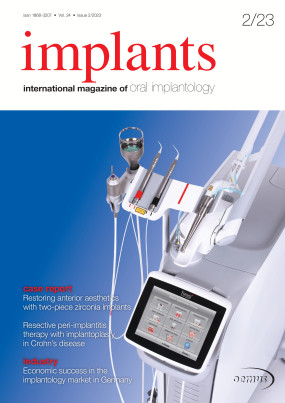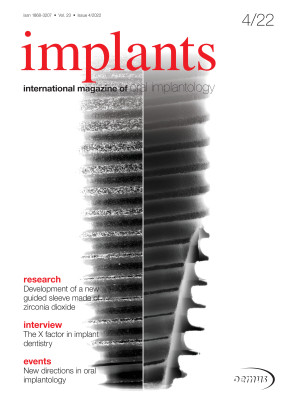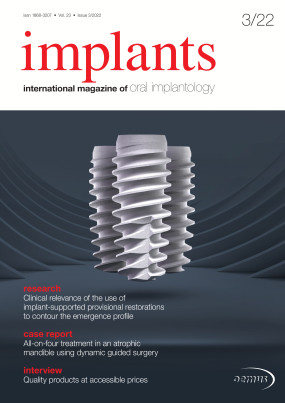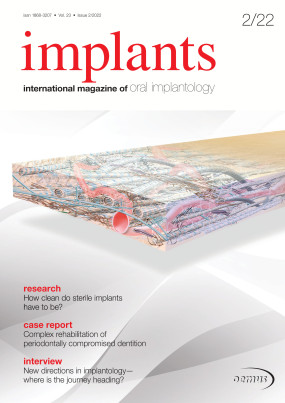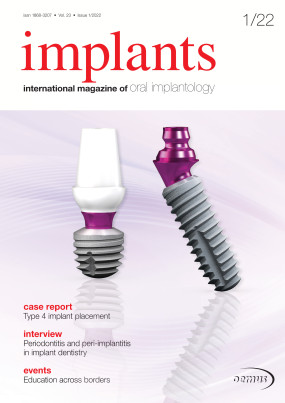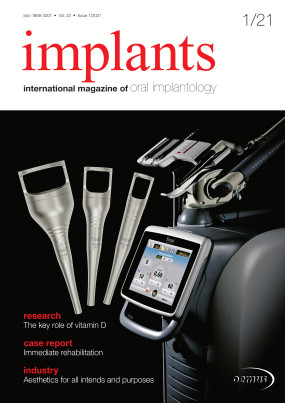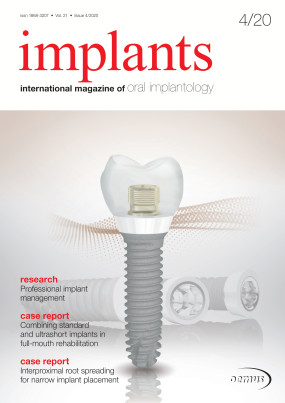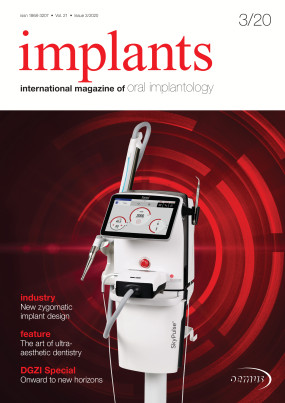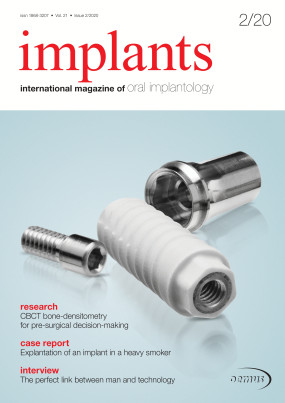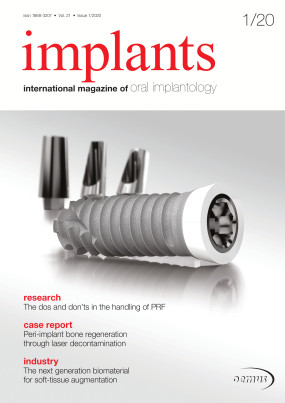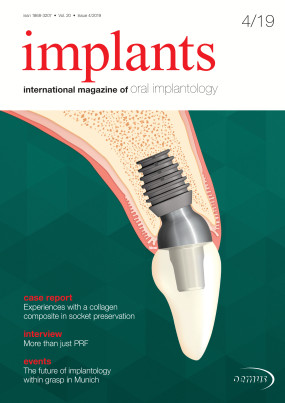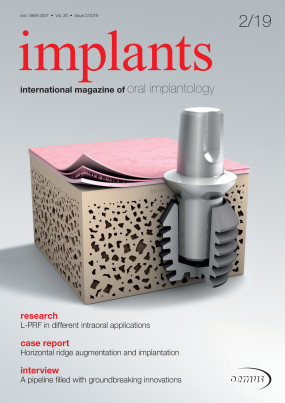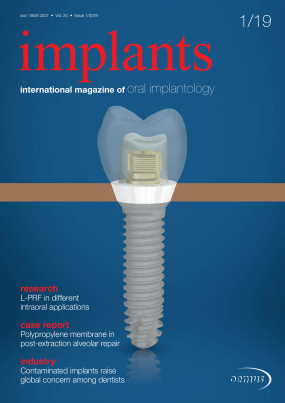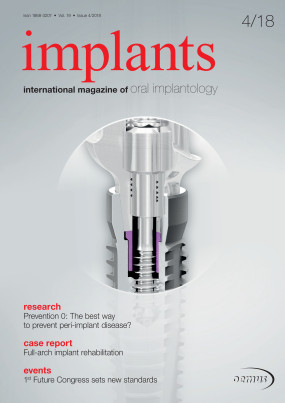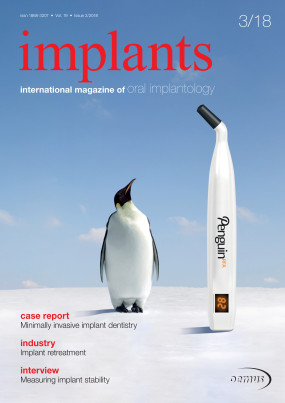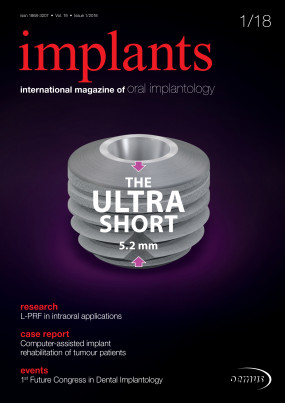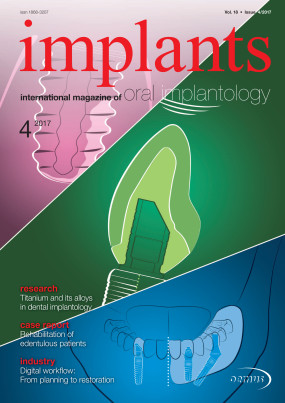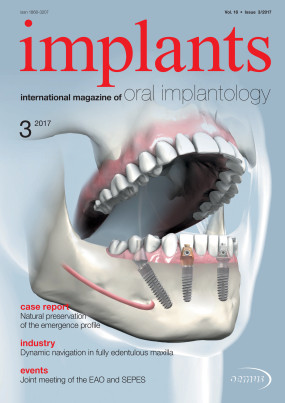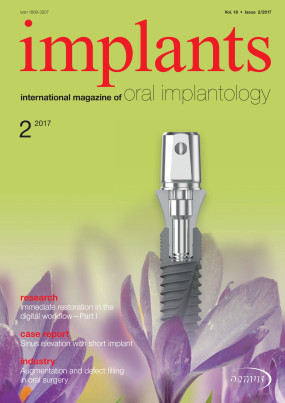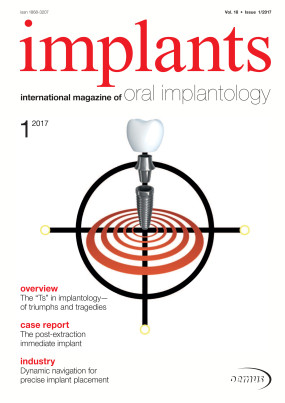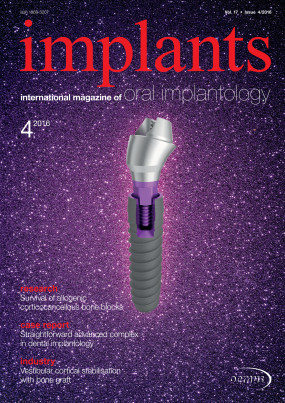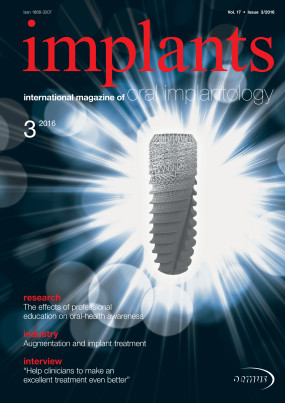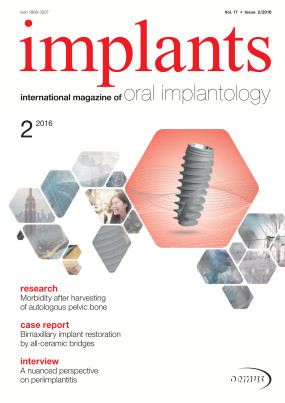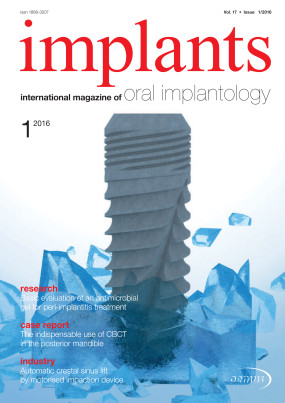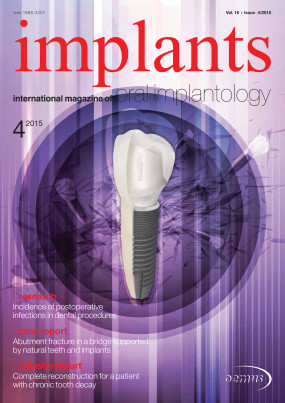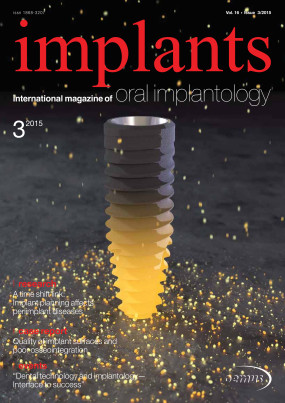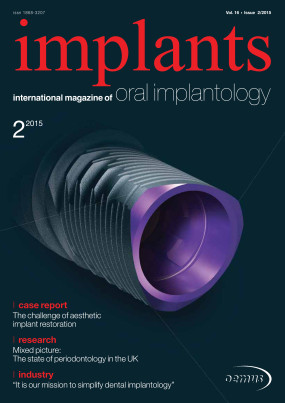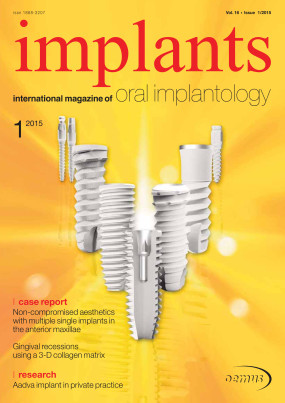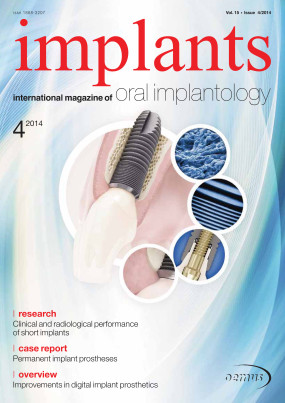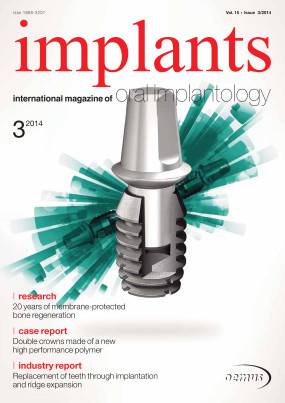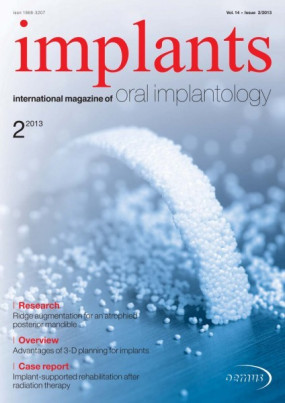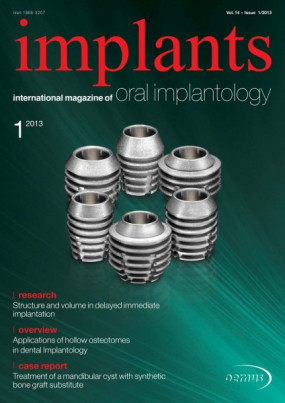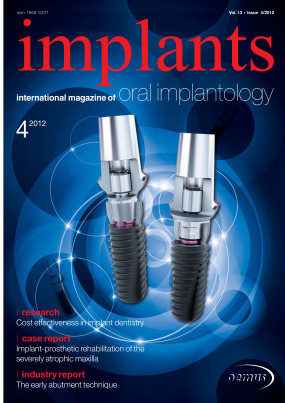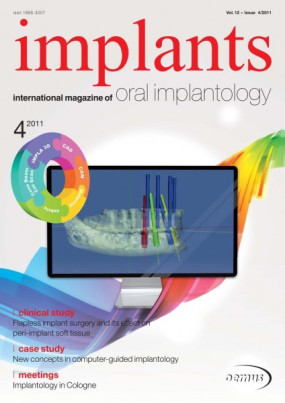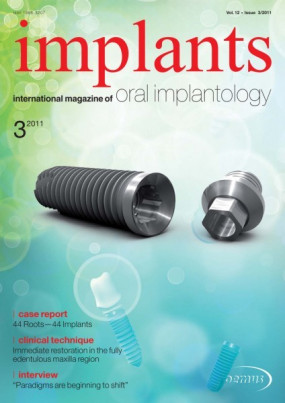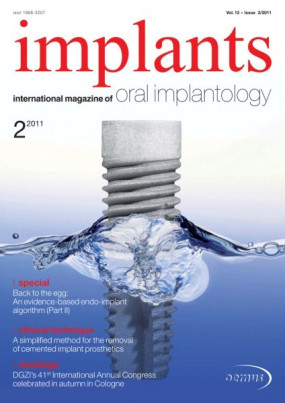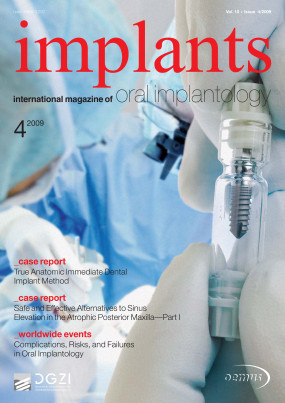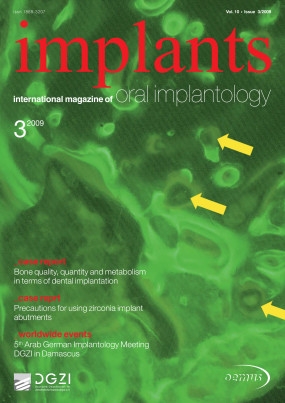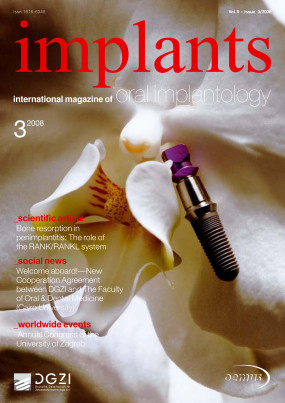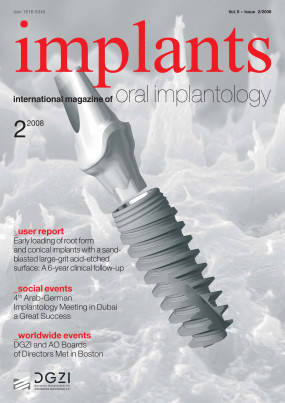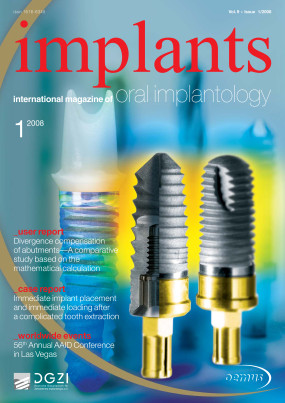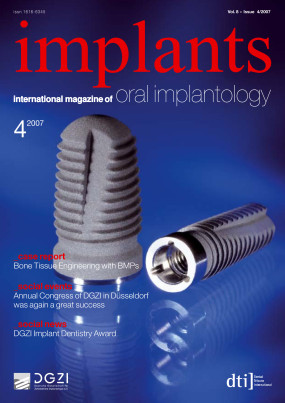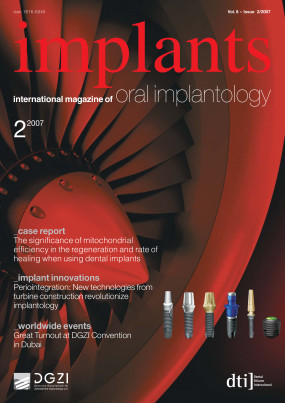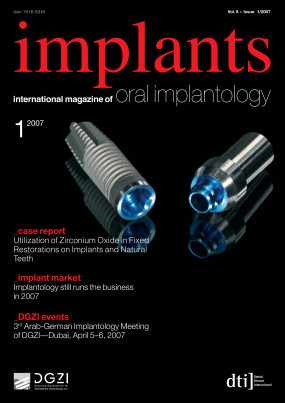Inhaltsverzeichnis
3
Now that we are on the verge of IDS, International Dental Show, I personally am eager to see what is going to be presented, especially with regard to the latest developments in bone augmentation materials. Osteogenesis takes place only in the sense of enclosing newly formed bone, which remains a biofunctionally foreign body within the augmented area for many years. The maxillary sinus seems to be a special subject and location with regard to osteogenesis. In sinus lift procedures with or without simultaneous implantation, many materials are working very well because of its special conditions. Lundberg et al. found out that the sinus is a sterile cavity. Its sterility is based on the epithelium cells’ potential to produce nitric oxide, which has an aseptic effect. Another important factor for the regeneration of the augmented material is the blood supply, according to Benner and Schlehhuber...
6
Delayed immediate implantation is a viable alternative to immediate implantation, for which there is no distinct evaluation in the literature, and a “regular” implantation after complete osseous healing of the former extraction area, generally associated with volume loss...
14
Mini implants: a useful complement to conventional implants?
Dr Friedhelm Heinemann, PD Dr Torsten Mundt & Prof. Dr Christoph Bourauel, Germany
Mini dental implants with a diameter of less than 3 mm have been used increasingly often in dental implantology. Several years ago, they were typically placed in combination with conventional implants and served as provisional solutions for the stabilisation of dentures during the healing phase.5 Today, they are also approved for long-term use. On the one hand, mini dental implants are placed to fix complete or partial dentures and contribute to increased stability. One the other hand, they are used as abutments for fixed bridges in specific situations, e.g. in small gaps...
20
Ridge augmentation for an atrophied posterior mandible - NanoBone block versus allograft bone block (Part I)
Dr Omar Soliman, Prof. Dr Mohamed Nassar, Ass. Prof. Dr Mahmoud Shakal & Ass. Prof. Dr Eman Mohy El-din Megahed, Egypt
Alveolar bone first forms when the Hertwig’s root sheath develops from the tooth germ. The alveolar bone does not form in the absence of primary or secondary tooth development. The close relationship between the tooth and the alveolar process continues throughout life. Wolff’s Law (1892) states that bone remodels in relation to the forces applied. Every time the function of the bone is modified, a definite change occurs in the internal architecture and external configuration...
24
Applications of hollow osteotomes in dental implantology
Dr Rolf Vollmer, Dr Mazen Tamimi, Dr Rainer Valentin, Dr Suheil Boutros & Dr Martina Vollmer, Germany
In the early days of implant dentistry, the main objective was to achieve a good stability for removable dentures. However, the range of indications has changed quickly. Today, patients are treated although they have thin crestal bone or a poor bone quality. Poor bone quality is found in the categories D3 and D4 (according to Carl E. Misch, Table 1). In contrast to the lower anterior region, which often corresponds to category D1, categories D3 and D4 are found mainly in the posterior maxilla, but also in the premaxilla (Table 1, green marks)...
28
Trabecular Metal (Zimmer Dental), a porous (80 %) tantalum biomaterial with a trabecular structure for 3-D bone in-growth, has been used for over a decade in orthopaedic surgery.1 As a result of great success in orthopaedics, a new tapered, threaded titanium dental implant with a Trabecular Metal midsection was developed and tested in animal models, followed by human trials. The current findings suggest that Trabecular Metal implants with both on-growth and in-growth (due to active bone formation in the Trabecular Metal pores) provide good bone anchorage during early healing when placed in extraction sockets. The preliminary pilot study demonstrated that immediate loading of Trabecular Metal implants with non-occluding provisional restorations within 48 hours and definitive loading of the implants with fully occluding restorations seven to 14 days later in selected patients was safe and effective over the six-month follow-up period...
34
Treatment of a mandibular cyst with synthetic bone graft substitute
Dr Damian Dudek, Katarzyna So?tykiewicz, Krzysztof Helewski, Grzegorz Wyrobiec, Marzena Harabin-Slowinska, Grazyna Kowalczyk-Ziomek & Romuald Wojnicz, Poland
Radicular cysts appear as a result of pulp necrosis caused by inflammation, trauma or improper dental treatment. They are cavities enclosed by a wall of connective tissue with an inner epithelial layer, usually filled with fluid or pulp. Radicular cysts cause few clinical symptoms and are painless in many cases. Mobility of adjacent teeth may be noted, as well as swelling of the bone. If the cortical bone is thinned or destroyed by the growing cyst, cracking under palpation may be noticed. Although radicular cysts are benign, they grow slowly but steadily and may lead to complications, depending on their size and location. Large cysts in the mandible may cause pathological fractures...
38
Time proven clinical success of the SHORT™ implant
Prof. Dr Mauro Marincola, MDS Angelo Paolo Perpetuini, Dr Stefano Carelli, Prof. G. Lombardo, Italy & Dr Vincent Morgan, USA
In 1892, Julius Wolff, a German surgeon, published his seminal observation that bone changes its external shape and internal, cancellous architecture in response to stresses acting on it (Wolff’s law of bone modelling and remodelling). Therefore, it is a significant engineering challenge to design a short implant that biocompatibly transfers occlusal forces from its prosthetic restoration to the surrounding bone. It requires the understanding and application of many basic biological, mechanical, and metallurgical principles. It is paramount that the entire design of a SHORT™ implant optimises the effectiveness of each of its features within the implant’s available surface area and length. Clinical success cannot be met by any single implant design feature such as surface area, but rather requires the appropriate integration of all of its features...
45
IDS 2013 will continue a positive tradition that began 90 years ago, when the first dental show took place in Germany. More than 1,900 exhibitors from over 55 countries are expected to be in Cologne from 12–16 March 2013 for the world’s largest trade show for dentistry and dental technology. Thanks to the tremendous demand for space, the fair will also occupy Hall 2.2 in addition to Halls 3, 4, 10 and 11. Altogether, 150,000 m2 of gross exhibition space will be covered...
46
More than 500 attendees visit ISOI Conference in Tokyo/Japan
Dr Rolf Vollmer, Dr Rainer Valentin & Prof. Dr Mazen Tamimi
From 17 to 18 November 2012, ISOI president Dr Naotaka Sugiyama, conference president Dr Tomohiro Ezaki and Prof Shoji Hayashi from Kanagawa Dental College in Yokohama proved superb conference hosts. In his opening speech, Dr Sugiyama particularly highlighted the importance of the collaboration between ISOI and DGZI. To honour this partnership, ISOI, which has around 1,000 members, founded a DGZI Japan Section in 2007. Dr Sugiyama also emphasised the importance of the scientific exchange between the two partner associations for those Japanese members who want to maintain German dentistry standards, especially in the field of oral implantology...









